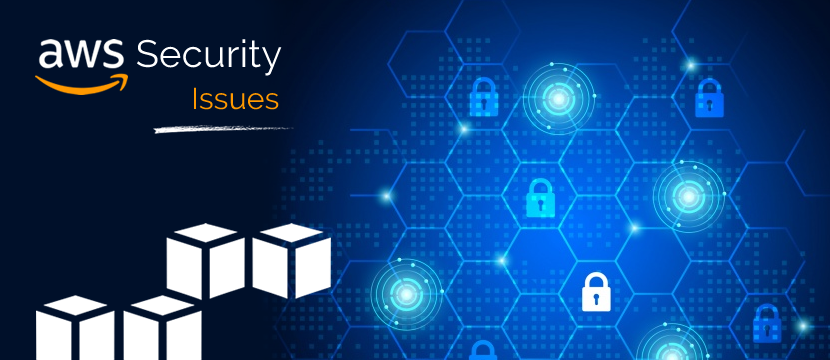AWS is one of the frontrunners in the cloud computing industry. Businesses and users received multiple advantages from AWS. The flexibility and wide assortment of services on the AWS platform are some of them. Also, AWS provided cloud-native transparency into activities and behavior in AWS environments.
However, most companies are focused on learning best practices to deal with AWS security issues. Why? Because organizations have to deal with emerging complexities in data and compliance requirements at every step of their cloud journey. So, every organization has to identify the most common security issues in AWS to develop best practices.
Also Read: What are AWS Managed Services?
Know About These 7 AWS Security Issues
If you have adopted Amazon Web Services (AWS) for your business then you should be familiar with the security issues associated with AWS. So, to help you out, the following discussion outlines seven of the common AWS security issues in detail.
1. Neglecting the security strategy
Many organizations are not aware of dealing with AWS security issues in the first place. This is where the concern of priority for security strategy arises! You can think that appropriate security tools and controls would be best in this case. By doing so, you are neglecting strategy. A security strategy helps in evaluating whether a particular tool suits your AWS cloud security.
Security strategy can help in dealing with AWS real-time issues! How? Your security strategy integrates into all business functions, such as operations and development. For example, you can implement security monitoring for configuration management tools used for automating software updates. The lack of a security strategy can leave you confused when you encounter security issues.
2. Lack of accountability
Accountability is the next entry in the list of AWS security issues. This is a formidable element in cloud security. Why? You have to know the individual responsible for a particular security incident for implementing appropriate remedial measures. AWS security best practices directly imply collective liability for security incidents beyond the virtual machine layer. However, this does not solve the problem of accountability.
Users have to take responsibility for audit logging, access control, and monitoring. This can help in determining access privileges, management of alerts, and approaches for monitoring applications and data. So, companies could follow a proactive approach in the definition of access level and network monitoring activity. This can be a promising intervention to deal with issues in AWS security by recognizing the responsible individuals precisely.
To deal with AWS security issues, It is very important to build the right AWS Consulting Practice. Read our previous article on how to build a successful AWS consulting practice for your business.
3. Compliance issues
Another prominent reason for AWS real-time issues is compliance. AWS has launched resources for ensuring data privacy as a response to GDPR. However, AWS cannot deal with every compliance requirement. You can get safeguards such as encryption of PII in rest and flight states.
However, it would not ensure continuous data monitoring to detect abnormal behavior or facility of host-level insights. On the other hand, it is difficult to find out where AWS cannot assure compliance, and you may need other solutions for compliance. Companies face the lack of patience and time to figure this out and often end up sticking to the on-premises solution.
4. A huge target for hackers
AWS security issues are also developed from its cloud-based services. Companies input substantial volumes of sensitive data such as financial reports and healthcare information to AWS. Therefore, attackers are most likely to target AWS data. One of the common ways in which AWS security incidents occur is credential theft.
Credentials can provide access to huge volumes of data by attacking a single data source. Examples of the attacks on AWS accounts of CodeSpaces and Timehop show the vulnerability of AWS cloud services to attackers. Therefore, AWS security best practices should be put in place in advance to safeguard your data and credentials.
Implementation of logging service at the host level, multifactor authentication, and monitoring anomalous logins are some of the recommended methods. Also, you can choose the AWS Secrets Manager for rotating credentials to provide a pre-emptive safeguard on your AWS data and credentials.
5. Failure to trust cloud security providers
As discussed before, AWS provides effective security tools and configurations for logging and monitoring. However, companies need to define where the responsibility of AWS ceases. So, it is important to look for cloud security providers and establish trust in their services to deal with security issues.
Companies should consult with cloud security providers regarding compliance, access to log data, and dealing with incident response. Companies should also aim at asking questions on cloud security to providers related to their industry and use cases. This can provide a definitive advantage in migrating to AWS cloud with confidence.
6. Clouding the security visibility
Security visibility in the cloud is also accounted for as one of the foremost AWS security issues. Companies use many cloud applications on AWS and associate various logins and controls with them. This creates confusion regarding the identity and location of individuals gaining access. As discussed before, a lack of security strategy with these applications can be highly dangerous for security visibility.
Therefore, organizations should look towards liability best practices to find out insider threats to AWS security. Also, it is essential to look into monitoring methods other than the use of logs. For example, the use of Host-based intrusion detection can work effectively for identifying the details of an attack comprehensively.
7. Data exposure in multi-tenancy environments
Multi-tenancy is also responsible for increasing the risks of data breaches. However, the security of infrastructure can help reduce the risk of AWS security issues. The lack of secure infrastructure is observed in cases of immature processes and untrained staff.
Similarly, companies could also face risks of data exposure to competitors with multi-tenancy. Therefore, companies should take additional precautions other than the security measures provided by AWS. Benchmarking of security maturity can be a promising method for securing your infrastructure in a multi-tenancy environment.
Looking for an AWS Consulting partner for your business? Check out the top 10 points you should consider while choosing an AWS Consulting Partner.
Conclusion
On a concluding note, migration to the cloud has become a mandatory requirement for companies. That is some good news as companies no longer think twice before migrating to AWS! However, as noted above, security issues are bound to pop up. Therefore, a clear understanding of the common AWS security issues presented in this discussion is mandatory.
You should always focus on verification of best practices for the security of your AWS infrastructure. As we noted in the discussion, AWS provides substantial security measures for your data. All you need is take some additional precautions on your behalf!










